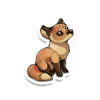
──────────────────────────────────────────────────────────────────────────────────

──────────────────────────────────────────────────────────────────────────────────
• Main Thread • Founders • Customs & MYOs • Shop • Nursery • Discord •
• Artist Search • Rules • FAQ • Genetics • Lore & NPCs • Shows • Fanclub • Staff •
• Artist Search • Rules • FAQ • Genetics • Lore & NPCs • Shows • Fanclub • Staff •
Here you can find some guides and color palettes to help you out when making artist entries or MYOs for Return!
Ticked tabbies are covered in speckles called ticking, and can be barred or unbarred. Unbarred ticked tabby is dominant, and will give a cat minimal tabby markings - most commonly on the face, but occasionally there will be some striping at the tip of the tail.
Barred ticked tabbies will show strong tabby markings on their face, legs, and tail, and will occasionally show breakthrough tabby along the sides.
Ticked is a gene that affects how the proteins that create tabby markings space themselves out, via occasionally malfunctioning and causing more of a color gradiant than actual striping. Essentially, imagine that tabby markings are painted on. The ticked gene takes the brush that's used to paint those nice, neat mackerel, classic, or spotted markings, and replaces it with a can of spray paint. Rather than orderly stripes of non-banded fur and a base coat of banded fur, you get a varying amount of even banding across all hairs.
Here is a step-by-step guide to doing ticked tabby!
Barred ticked tabbies will show strong tabby markings on their face, legs, and tail, and will occasionally show breakthrough tabby along the sides.
Ticked is a gene that affects how the proteins that create tabby markings space themselves out, via occasionally malfunctioning and causing more of a color gradiant than actual striping. Essentially, imagine that tabby markings are painted on. The ticked gene takes the brush that's used to paint those nice, neat mackerel, classic, or spotted markings, and replaces it with a can of spray paint. Rather than orderly stripes of non-banded fur and a base coat of banded fur, you get a varying amount of even banding across all hairs.
Here is a step-by-step guide to doing ticked tabby!
Step One wrote:1. Make the base coat. I find it easiest to brush on whatever rufusing and countershading may be there at this step!
Step Two wrote:2. Create a new layer and add Monochrome Noise to the drawing. Make sure that this layer is clipping with the base layer. You can find Monochrome Noise in the Effects tab in Oekaki, second from the bottom. Reduce the opacity of this layer to around 25-35%, or until you can clearly see the both the speckles and the base color.
Step Three wrote:3. Use the Soft Eraser tool on the round soft brush to soften the ticking. On an unbarred ticked tabby, there should be little to pale ticking along the belly and none on the paws. For a barred ticked tabby, there should be no ticking on the belly, paws, bottom half of the face, and about half of the tail. You can also use the Soft Eraser to soften the ticking on the sides to the color and opacity you want, keeping it darkest along the spine.
Step Four wrote:4. Add in your tabby markings. Regardless of if the cat has the McMc, Mcmc, or mcmc alleles, this will show was striping on the legs, face, and tail on a barred ticked tabby, and some tabby marks on the face and occasionally the tail for an unbarred ticked tabby.
Step Five wrote:5. Soften the tabby with the Soft Eraser tool. For an unbarred tabby, you may do this to may the ear markings gradient, make the eyeliner markings less solid, or to fade out any tail tabby you may have added. On a barred ticked tabby, you will need to soften the tabby markings along the legs so that they are palest at the shoulder and darkest at the paws, and make it so that the tail markings are palest at the base and darkest at the tip.
For Silvers wrote:Follow the same steps as above, but make the base a light silver. The tabby color should only be shown where there is ticking and tabby markings.
For Lynx Points wrote:Follow the same steps for points and then apply ticking and tabby stripes, leaving some ticking along the cat's spine and sides.




